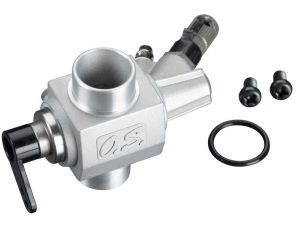There is a popular saying, “Takeoffs are optional, but landings are mandatory,” and for us RC pilots this is most relevant.. If your engine is not properly tuned, the landings or possible "deadsticks" can become very interesting to say the least. Landings need precise throttle control as you begin your descent on approach. Deadstick aptly named if your engine quits is to be avoided at all costs especially if you are downwind and have little or no chance of attempting to glide back to your field unless you have significant height when it happened.
Although questions on tuning glow engines does create many and numerous answers, just search the internet as you will be presented with hundreds or more. However, here is our guide to setting the engine up right which we pass on to our members.
Safety! Ensure your model is restrained at ALL times either another person or preferably a model metal restraint when starting the engine or when running until such time you are ready to taxi out and fly.
Bear in mind that if you change your fuel brand or nitro methane content you may have to retune the engine although not always as some engines are not quite so fussy. Also note that although a two stroke carburettor is pictured the same procedure goes for four stroke engines although the four stroke carburettor has a slightly different design.
Glow Engine Tuning
PART ONE - MAIN NEEDLE ADJUSTMENT
- Charge the tank to about 1/3 full only.
- Open the throttle wide and close the needle completely.
- Open the main needle three whole turns from closed.
- Place a finger over the air intake and rotate the propeller 6 times.
- Remove finger and close throttle to one third open.
- Connect glow starter.
- Start engine.
- Gently (important) open throttle to full.
- Remove glow starter.
- Hold the model nose up at approx 60 degrees.
- Close main needle until engine RPM peaks.
- Open main needle one or two clicks back from absolute peak RPM.
DO NOT TOUCH THE MAIN NEEDLE SETTING FROM THIS POINT!
PART TWO – IDLE (LOW) NEEDLE ADJUSTMENT
- Close throttle to one quarter (i.e. fast idle).
- OPEN LOW needle one quarter turn.
- WAIT 5 seconds and observe results.
- If idle RPM SLOWS, close secondary needle back to where it was.
- Close secondary needle one further quarter turn.
- WAIT 5 seconds and observe results.
- If engine RPM speeds up then you are moving in the right direction - opening and closing the secondary needle setting until idle speed peaks is your goal.
- Open throttle wide and check response.
- If engine hesitates open secondary needle a LITTLE.
- If engine splutters and and throws fuel droplets from the air intake, close secondary needle a LITTLE.
- Open throttle wide and recheck the MAIN needle setting with the nose of the model raised then again check peak rpm and back off one or two clicks. This is because the on a steep climb the engine will tend to lean out so we add a little bit of rich (200 -300 rpm) to compensate.
*Derived from a Stephen Dorling article

